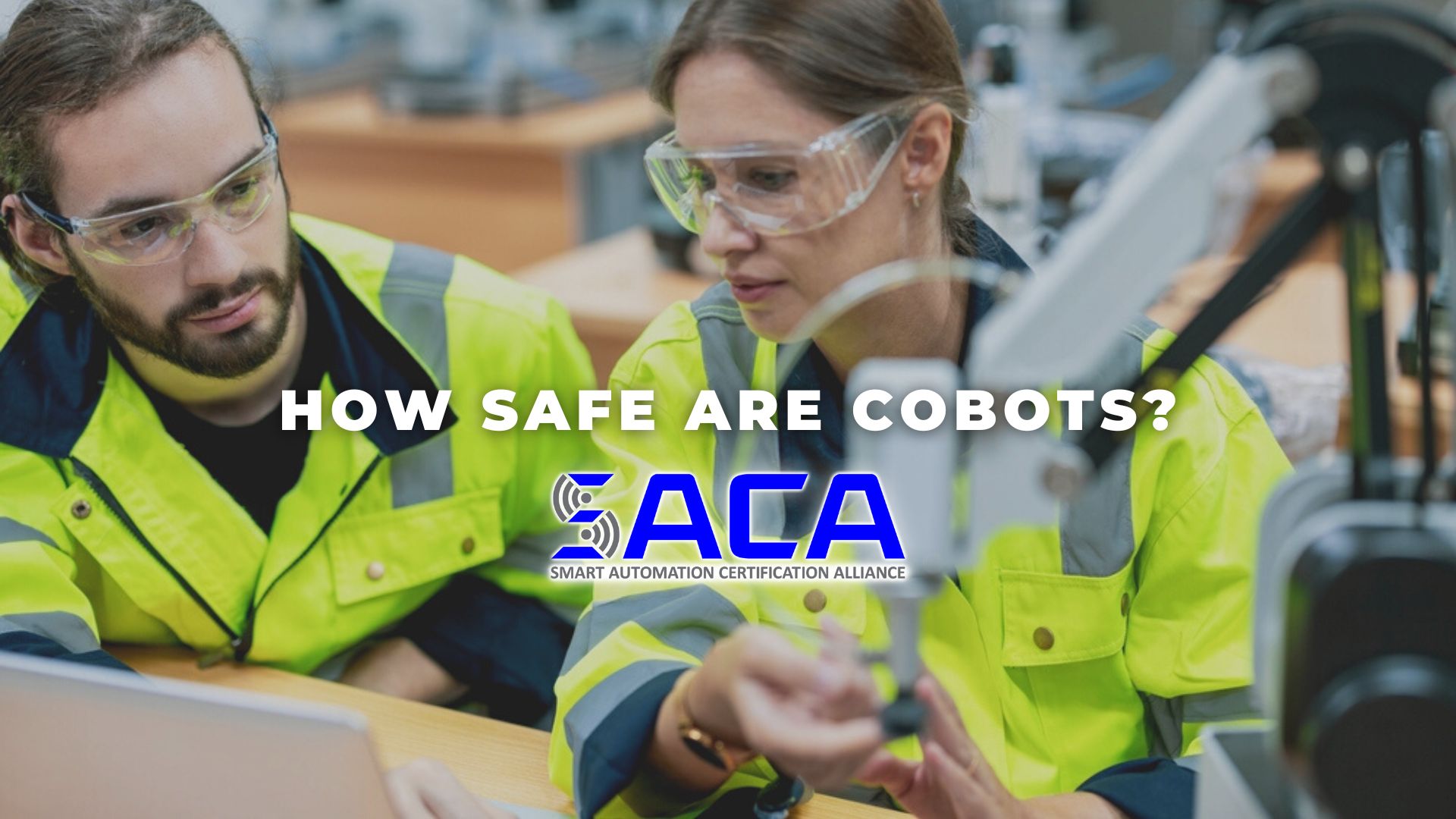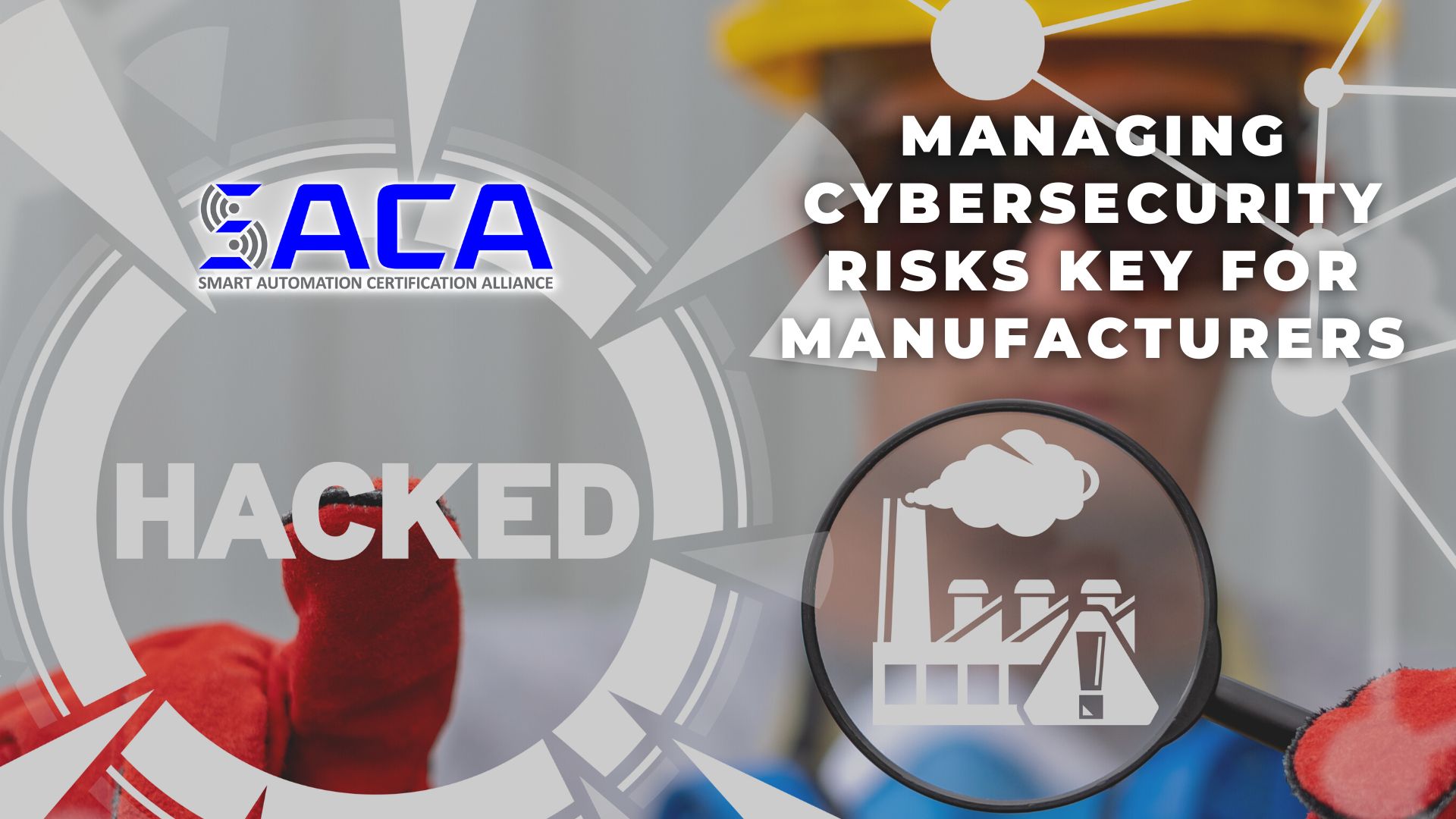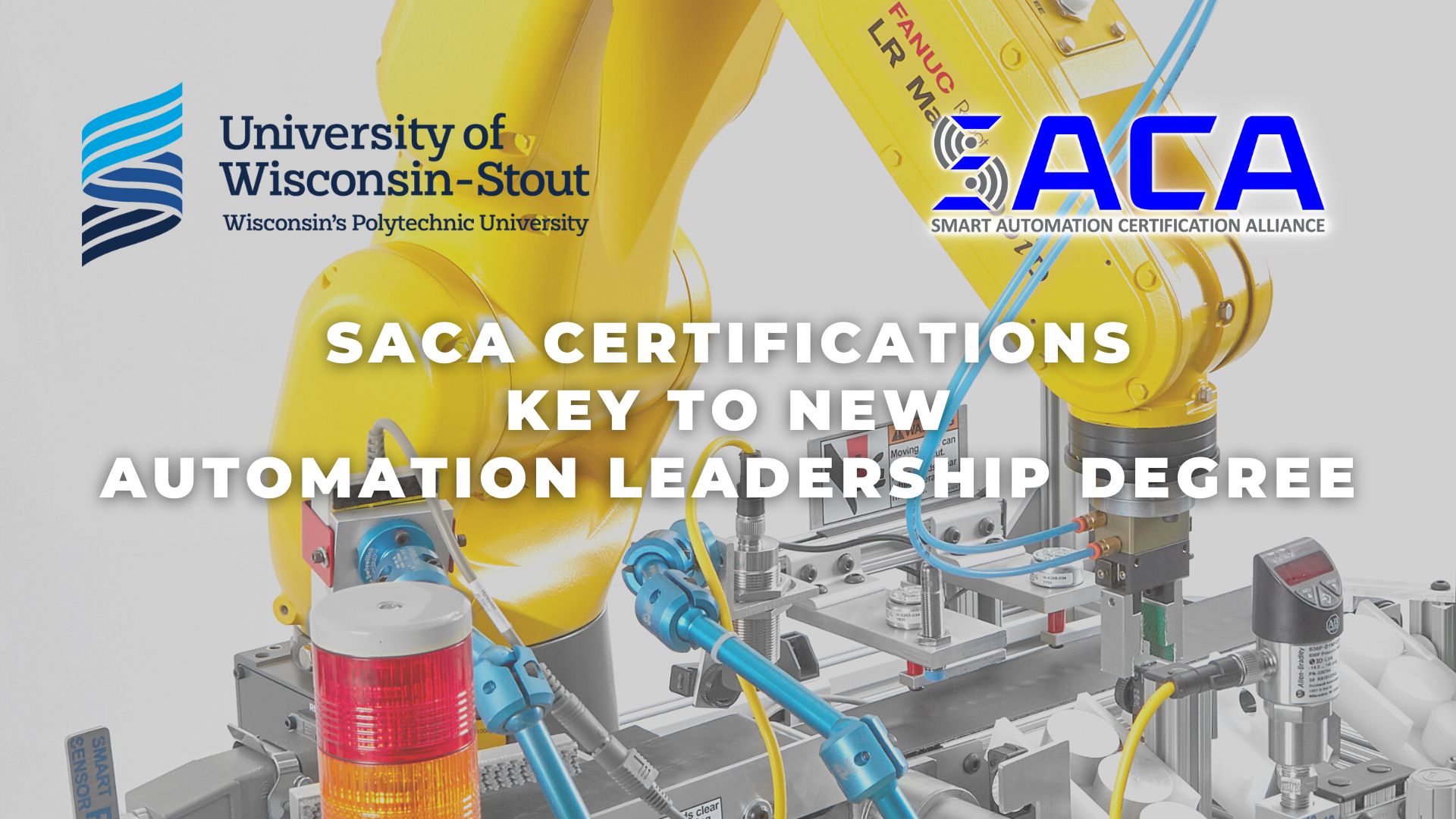Artificial Intelligence Saves Energy Costs in Iron Foundry
Will Artificial Intelligence Impact Every Industry?
Artificial Intelligence (AI) seems to be everywhere you look these days. Some laud AI as an exponential step forward in what technology can do to transform our jobs and lives. Others fear AI could be dangerous if used nefariously. Of course, authors like Carlos E. Perez in a recent Medium article jokingly play devil’s advocate: “Do you know what’s more dangerous than artificial intelligence? Natural stupidity.”
In all seriousness, it’s clear that AI has arrived and is here to stay. We’ve only seen the tip of the iceberg when it comes to its applications. Manufacturers across the country and around the world are already implementing AI solutions in a variety of ways. For example, in a recent TechTarget article by Lindsay Moore, the author gives several examples of ways manufacturers are using AI today, including:
- collaborative robots (cobots) working alongside humans;
- robotic process automation (RPA) software handling tedious and repetitive tasks;
- digital twins providing insight into the performance of machinery;
- predictive maintenance improving safety and lowering costs;
- lights-out factories utilizing a robotic workforce with minimal human interaction;
- machine learning algorithms predicting demand;
- inventory management systems smoothing out supply chain issues; and
- visual inspection systems detecting faults in real time.
Some manufacturers may look at a list like this and fail to see how AI could help their particular industry. After all, aren’t there some industries that tend to be more on the low-tech side of things? Take your average iron foundry, for example. Melting down metal, pouring it into a mold, and letting it cool to solidify to make a wide variety of cast metal objects doesn’t seem like it would hold great potential for implementing AI, right? Wrong!
A recent Foundry Management & Technology article details how Danish iron foundry Vald. Birn A/S implemented AI technologies ”to optimize the process of filling sand molds,” resulting in significant energy savings. The foundry produces cast metal “parts for commercial vehicle manufacturng, construction and material handling machinery, hydraulic systems, transmission systems, heavy machinery, and defense systems.”
According to the article, the foundry adopted new AI technology “to monitor and analyze molten-metal pouring.” Here’s a brief breakdown of how it works:
“two laser beams are positioned to precisely locate a molten metal stream as it enters the mold, to control pouring in a way that is repeatable and reliable. As the stream enters the mold, sensors collect pouring performance data and software evaluates the information to continuously optimize parameters, to avoid slag build-up, variations in temperature and launder level, wear conditions for the stopper and nozzle, and similar problems that reduce dosing effectiveness.”
Birn CTO Lars Jørgensen noted that “[t]he technology helps us save a significant amount of energy because precise dosing into the molds is essential for determining the exact amount of energy needed to fill the molds adequately and allow the molten metal to flow perfectly into the molds.”
Iron foundry workers need not be worried about being replaced by AI, however. Jørgensen explained that “[t]he technology is a great aid to our operators, but it certainly cannot replace them in the whole process. It essentially serves as a skilled assistant, helping to optimize the pouring processes while operators can take samples of molten iron and perform other specialized tasks.”
Even if AI does not replace workers, the workers of today and tomorrow will need to learn new skills to keep pace with the advanced technologies being implemented in the modern workplace. That’s why manufacturers are increasingly looking to hire highly skilled workers that can operate, maintain, troubleshoot, and repair advanced automation systems.
Unfortunately, due to the ongoing “skills gap” facing industries across the country, finding highly skilled workers remains a significant challenge. How can employers be sure that workers have the hands-on skills they need to succeed in the modern workplace? Today, more and more employers are looking for workers with industry-standard certifications that prove they have the skills needed.
For example, if workers possess a certification from the Smart Automation Certification Alliance (SACA), employers can feel confident they’ve already proven they have the knowledge and hands-on skills needed for working with advanced smart automation technologies. SACA has been hard at work collaborating with industry leaders to develop a wide variety of industry-standard certifications that will help employers find workers who possess the advanced connected-systems skills they need to take their businesses to the next level. Be sure to check out SACA and all it has to offer!
- Published in News
Lean Manufacturing Goes Digital
“Digital Lean” Adds Value by Focusing on Specific Process Improvements
If you work in the manufacturing industry, there’s a good chance you’re familiar with the concept of lean manufacturing. This production system that focuses on eliminating waste and maximizing productivity is based upon guiding principles that date back to the late 1950s and early 1960s.
According to a recent Industry Week article by Doug Berger and Conrad Leiva, “Lean has played a significant role for the past few decades in driving efficiency across manufacturing organizations by providing people with the data and methods for eliminating waste, improving factory flow and focusing on customer value. Lean techniques have promoted simple, intuitive visual and analytical approaches to decision making, problem-solving and continuous improvement.”
Thanks to modern advanced automation technologies, there’s been renewed interest in lean manufacturing and its possibilities. Berger and Leiva note that “[t]he ‘digital lean’ movement stays true to lean principles while taking advantage of the real-time and data-centric techniques from smart manufacturing and Industry 4.0.”
Digital lean doesn’t just promote technology for the sake of the latest and greatest, though. To be most effective, digital lean “works best when the operations improvement team pulls in technology to add value for specific process improvements.”
According to Berger and Leiva, “technologies like automated data collection, analytics platforms, digital dashboards, artificial intelligence and integrated workflow systems” can result in “even greater levels of efficiency, quality, velocity and adaptability in operations.”
The authors point out three key areas where “the added value that well-placed digital technology can bring to a lean effort”:
- Reducing Waste: Advanced automation technologies can improve waste reduction by:
- using predictive maintenance to reduce downtime;
- using real-time detection to reduce defects; and
- using enhanced value stream mapping (VSM) to reduce waste.
- Reducing Inventory: New Industry 4.0 technologies can improve inventory efficiency by:
- using automated material tracking to minimize inventory waste; and
- using automated material handling systems to improve flow throughout a facility.
- Improving People Utilization: Adding the right smart technologies can improve people utilization by:
- using real-time digital dashboards to improve work rhythm;
- using digital work instructions to reduce errors;
- creating paperless processes to eliminate unnecessary clerical steps; and
- using online training to improve talent use.
Getting started on a digital transformation to improve efficiency and productivity can seem like a monumental task. Berger and Leiva encourage manufacturers to “prioritize your areas of opportunity” and “for each step in your journey to build on the prior one and lay a good foundation for expanding future capabilities. Keep your options open.”
Of course, manufacturers will also need the right personnel to put digital lean plans into action. That’s why it’s critical for manufacturers to hire highly skilled workers that can operate, maintain, troubleshoot, and repair the advanced automation systems that are implemented as part of digital lean initiatives.
Unfortunately, due to the ongoing “skills gap” facing industries across the country, finding highly skilled workers remains a significant challenge. How can employers be sure that workers have the hands-on skills they need to succeed in the modern workplace? Today, more and more employers are looking for workers with industry-standard certifications that prove they have the skills needed.
For example, if workers possess a certification from the Smart Automation Certification Alliance (SACA), employers can feel confident they’ve already proven they have the knowledge and hands-on skills needed for working with advanced smart automation technologies.
SACA has been hard at work collaborating with industry leaders to develop a wide variety of industry-standard certifications that will help employers find workers who possess the advanced connected-systems skills they need to take their businesses to the next level. Be sure to check out SACA and all it has to offer!
- Published in News
Risk Assessment Still Essential to Ensure Cobot Safety
As advanced automation technologies have become commonplace in industrial workplaces over the last decade, many workers have feared that their jobs would soon be replaced by these technologies, such as robots. However, while some dangerous, overly-repetitive job tasks have been taken over by industrial robots, these technologies have actually created a variety of new jobs centered on their installation, operation, maintenance, troubleshooting, and repair.
Moreover, many workers now find themselves working right alongside robots that make their jobs easier and safer. These robots, known as collaborative robots or cobots, tend to be smaller, slower-moving versions of their industrial robot counterparts.
Cobots are designed to operate at slower speeds and with more safeguards than traditional robots, so that they can safely operate in close proximity to human workers. Despite these design considerations and the safety record of cobots, experts argue that ongoing risk assessment remains essential to ensure cobots and human workers continue to work safely together.
According to a recent Automation World article by David Greenfield, “beyond the built-in safety aspects of cobots—such as smooth, rounded edges to minimize pinch points, slow operating speeds and lighter load capacities—key safety regulations have been introduced to help ensure a safe working environment.”
For example, “ISO/TS15066 clearly calls out that a risk assessment is necessary to identify the hazards and risks associated with a collaborative robot system application. It notes that the integrator ‘shall conduct a risk assessment as described by ISO 10218 and ANSI/RIA15.06’.”
Risk assessment of automated industrial applications seems like a no-brainer, right? Unfortunately, “cobot risk assessments are commonly overlooked in industry.” Why? Probably because “[t]heir use in industry over the past 10+ years has proven their ability to be used safely.”
According to Greenfield, “[t]ypical application hazards, such as impact questions, trapping and projectiles are often overlooked once the term collaborative robot is used because it’s taken that this is a safe piece of equipment. But this is why a risk assessment is required. So you have to look at the loads, the materials and the robot torque.”
It’s also important to assess risk “related to the cobot’s location. Based on where the cobot is located, you have to consider if you are creating a crushing or a trapping hazard with the cobot. You also have to consider if the cobot position is high enough that it could come into contact with an operator’s head.”
“The bottom line for cobot safety is to: 1) Not assume it will always be safe to use alongside humans just because it’s a cobot; and 2) Identify the hazards and risks associated with your planned use of the cobot using the available safety standards.”
Does your organization use cobots in the workplace? If so, do you have risk assessment procedures in place to ensure worker safety? These types of questions are why it’s critical for industries to hire highly skilled workers that can manage risks, in addition to operating, maintaining, troubleshooting, and repairing the advanced automation systems that are being implemented.
Unfortunately, due to the ongoing “skills gap” issue facing industries across the country, finding highly skilled workers remains a significant challenge. How can employers find the workers they need? And how can they be sure that workers have the hands-on skills they need to succeed in the modern workplace? Today, more and more employers are looking for workers with industry-standard certifications that prove they have the skills needed.
For example, if workers possess a certification from the Smart Automation Certification Alliance (SACA), employers can feel confident they’ve already proven they have the knowledge and hands-on skills needed for working with advanced smart automation technologies. SACA has been hard at work collaborating with industry leaders to develop a wide variety of industry-standard certifications that will help employers find workers who possess the advanced connected-systems skills they need to take their businesses to the next level. Be sure to check out SACA and all it has to offer!
- Published in News
SACA/MICHauto/MWTEC/LEO Electric Vehicle Certification Summit
Join us for the SACA/MICHauto/MWTEC/LEO exclusive Electric Vehicle Certification Summit
The Smart Automation Certification Alliance (SACA) is partnering with MICHauto, the Michigan Workforce Training and Education Collaborative (MWTEC), and the Michigan Department of Labor and Economic Opportunity (LEO) for the Electric Vehicle Certification Summit. The Summit will include in-depth discussion about what industry-approved certifications are needed to train and upskill the Electric Vehicle and Electric Battery workforce. This event will also include the development of standards and validation of SACA’s Electric Vehicle Battery Basics certification.
We’re calling on automotive industry experts to attend the Summit and offer your expertise. This is an opportunity for your organization to have input on the skills and competencies needed for today’s Electric Vehicle and Electric Battery workforce.
Your input will be used to create nationally-recognized, occupation-driven certifications and EV training programs for careers like Operator/Assembler and Technician/Skilled Tradesman. Additionally, SACA will seek your feedback on future needs of industry and technology trends that will help shape their strategy moving forward.
Interested? Here are the details:
SACA/MICHauto/MWTEC/LEO Electric Vehicle Certification Summit
December 7, 2023
MICHauto
One Kennedy Square
777 Woodward Ave, Suite 800
Detroit, MI 48226
For more information including an agenda, download the brochure.
About SACA
SACA sits at the forefront of the effort to certify students and workers who demonstrate the required knowledge and hands-on smart automation skills employers so desperately need. SACA’s certifications were developed in conjunction with industry partners who could speak from experience about their needs when it comes to workers able to work alongside a variety of advanced automation technologies.
SACA offers a wide variety of certifications in popular industrial skill areas, including certifications at the Associate, Specialist, and Professional level. For those wishing to focus on building a strong foundation of skills employers need, SACA also offers many micro-credentials that allow students and workers to add certifications as they master new areas.
For workers, SACA certifications can help market their smart automation skills to potential employers. For those employers, SACA certifications represent confirmation that a worker has the skills to hit the ground running in the workplace. To learn more about Industry 4.0 certifications and how SACA can help both future workers and industrial employers begin the task of bridging the Industry 4.0 skills gap, contact SACA for more information.
- Published in News
How Safe is Your Plant Floor from Cyberattacks?
Do you work in a smart factory? From the smartphone in your pocket to the smart thermostat on the wall at home, devices that are part of connected systems have taken over our modern lives, and that includes the factory floor.
Even if your industrial facility isn’t filled with a bunch of robots or a fleet of automated guided vehicles, chances are good that at least some advanced automation technologies have made their way into operations in some way, shape, or form. And if they haven’t yet, these technologies are sure to appear soon.
Manufacturers everywhere have embraced new automation technologies because they improve productivity, efficiency, and ultimately profitability. However, as manufacturers add more and more smart devices to their networks, the risk of cyberattacks on those devices increases accordingly.
The bad actors behind the cyberattacks that have made the news in the last few years know that manufacturers often implement new technologies before adding the highly skilled workers they need to keep those advanced systems safe. How safe is your plant floor from cyberattacks?
According to a recent Automation World article by Matt Smith, “[i]ndustrial control systems (ICS) and operations technology (OT) are vulnerable to cyberthreats and vulnerabilities that target crucial industrial processes. The effects go far beyond data breaches and have the power to upend entire industries, jeopardize security and even put lives in danger.”
Smith provides several examples of the types of problems that can arise if a facility’s cybersecurity isn’t managed properly:
- “Any successful cyberattack on OT/ICS technologies could cause system downtime and significantly reduce productivity…As a result, financial impacts can be significant, with losses in market reputation and investor confidence in addition to revenue losses.”
- “[A] cyberattack on the control systems of a power plant could cause power outages that would impact not only businesses but also homes, hospitals and other vital services that depend on electricity.”
- “Accidents and fatalities can result from a successful attack on transportation infrastructure, such as rail networks or traffic control systems.”
- “Pipeline or chemical plant control system breaches can cause spills, leaks and other environmental catastrophes with long-term ecological and financial repercussions.”
How can manufacturers take steps to minimize the risk of cyberattacks? According to Smith, “strong cybersecurity measures are increasingly necessary to reduce these risks as industries place a greater reliance on connected systems. Businesses need to understand that cybersecurity is a key component of their overall risk management strategy, not just an IT issue.”
That’s why it’s critical for manufacturers to hire highly skilled workers that can manage cybersecurity risks, in addition to operating, maintaining, troubleshooting, and repairing the advanced automation systems that are being implemented. Unfortunately, due to the ongoing “skills gap” issue in the manufacturing sector, finding highly skilled workers remains a significant challenge.
How can manufacturers find the workers they need? And how can they be sure that workers have the hands-on skills they need to succeed in the modern workplace? Today, more and more manufacturers are looking for workers with industry-standard certifications that prove they have the skills employers need. For example, if workers possess a certification from the Smart Automation Certification Alliance (SACA), employers can feel confident they’ve already proven they have the knowledge and hands-on skills needed for working with advanced smart automation technologies. SACA has been hard at work collaborating with industry leaders to develop a wide variety of industry-standard certifications that will help employers find workers who possess the advanced connected-systems skills they need to take their businesses to the next level. Be sure to check out SACA and all it has to offer!
- Published in News
SACA & Endress+Hauser Seek Experts for Technical Work Group
The Smart Automation Certification Alliance (SACA) is pleased to announce that it is partnering with Endress+Hauser to host an exclusive Process Control Technical Work Group meeting on November 28, 2023, in Greenwood, Indiana.
SACA and Endress+Hauser need experts in the process control and instrumentation industry to help validate certification standards for process control in four key areas:
- Process Control Systems 1-Flow and Level
- Process Control Troubleshooting 1
- Process Control Systems 2-Temperature
- Smart Process Instrumentation 1
This meeting represents your opportunity to provide input on the skills and competencies needed for today’s smart manufacturing workforce. Your input will be used to create nationally-recognized, occupation-driven certifications. Additionally, SACA will seek your feedback on future needs of industry and technology trends that will help shape its strategy moving forward.
Why should you participate? Not only will you gain recognition as a national leader in process control automation and first access to state-of-the-art industry standards, but you’ll also ensure that your company’s skill needs are addressed by a nationally-recognized certification.
Interested? Here are the details:
SACA and Endress+Hauser Process Control Technical Work Group
November 28, 2023
Endress+Hauser Inc.
2355 Endress Place, Greenwood, IN 46143
Click here to download a flyer with the agenda.
Plan to attend? RSVP here.
About SACA
SACA sits at the forefront of the effort to certify students and workers who demonstrate the required knowledge and hands-on smart automation skills employers so desperately need. SACA’s certifications were developed in conjunction with industry partners who could speak from experience about their needs when it comes to workers able to work alongside a variety of advanced automation technologies.
SACA offers a wide variety of certifications in popular industrial skill areas, including certifications at the Associate, Specialist, and Professional level. For those wishing to focus on building a strong foundation of skills employers need, SACA also offers many micro-credentials that allow students and workers to add certifications as they master new areas.
For workers, SACA certifications can help market their smart automation skills to potential employers. For those employers, SACA certifications represent confirmation that a worker has the skills to hit the ground running in the workplace. To learn more about Industry 4.0 certifications and how SACA can help both future workers and industrial employers begin the task of bridging the Industry 4.0 skills gap, contact SACA for more information.
- Published in News
Instructor Profile: Maroun Nehme
Maroun Nehme, director of Buena Park High School’s Advanced Robotics and Mechatronics program, started folding SACA into his program shortly after he became the head of it. He said it started off as a way to get something in the hands of students along with their diplomas, but it’s turned into a lot more.
He got his Gold SACA instructor certification and began testing his students for the Gold credentials. After seven students passed the Silver exam, six attempted and passed the Gold exam.
“We became the very first college or high school in California to have Gold Certified students and a Gold Certified instructor,” Nehme said.
He said he wanted to make sure his students got a little recognition, so he began posting their projects and accomplishments on social media.
That’s when his community began taking notice. A councilman for the Buena Park City Council saw the hands-on training in action, and asked Nehme to bring his students to a public meeting to honor them and their work. He also said industry began taking notice and wanted to see how they could benefit from Nehme and his lab.
“Their parents were super stoked and I think it just gives more recognition to the program,” Nehme said. “And now we’re beginning to partner up with some companies that may use my classroom as a training facility for their employees, which is pretty big for a high school.”
He said it was a big deal, especially since he wasn’t sure how to deliver SACA curriculum at first. Nehme said a presentation from Joe Russo at Klein Educational Systems helped him see how to keep things moving. Working with students in pods helped him make sure he could keep 30 students going at once and still give them time to test on the necessary skills.
Watching them gain interest in the first year is huge, he said, and part of that is how the initial curriculum is built.
“I like the 101 curriculum because it gives students a taste of everything,” Nehme said. “It doesn’t go super deep into anything, but it gives them a taste of all these different things, whether it’s electrical, pneumatics or robotics. They go into year two, they’re doing the same thing and they can decide what they want to learn, what they want to pursue.”
He said that gives them opportunity once they graduate outside of just going to a four-year institution. He said it helps motivate students while they’re in high school, and find paths to high-paying careers once they graduate.
“I think one of the roles that SACA fills is provide for not just the students, but their parents, a purpose for them to go to school,” Nehme said. “They would like them to get into some kind of career where they can learn a trade and earn a decent living, especially in Southern California. If a student wants to go into a field, they can stack those certifications and use them to get a job.”
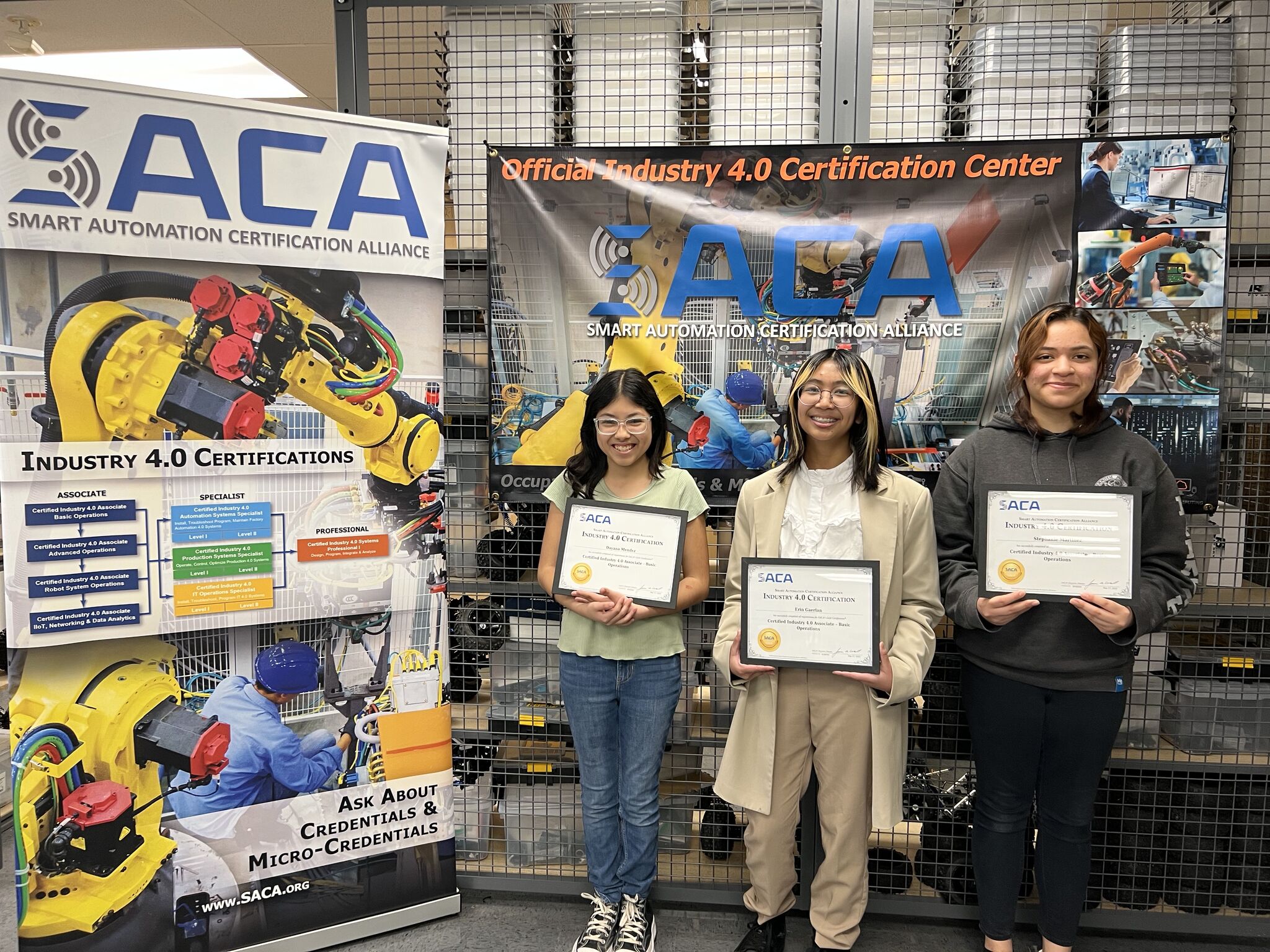
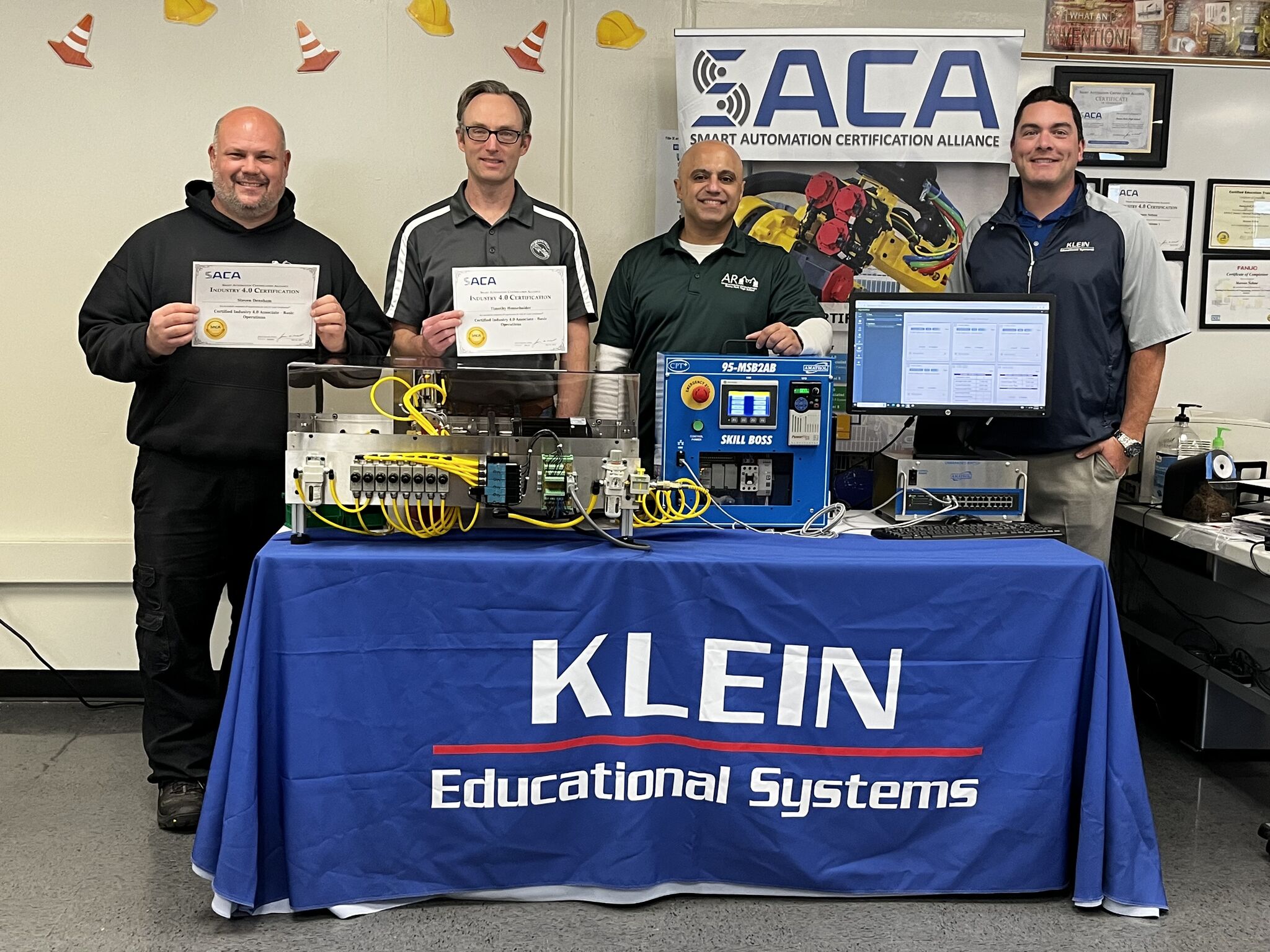
- Published in News, Technology
Believe the Hype: The Current State of Smart Manufacturing
It’s no secret that technology has changed our personal lives in ways few could have foreseen decades ago. But to what extent has technology changed the way we work?
People unfamiliar with the manufacturing sector might assume that factories where people work with their hands to make things might not be on the frontier of technological progress. However, they might be surprised to learn that the nation’s manufacturing facilities are driving forces when it comes to advanced technology.
There’s even a name for the technological revolution taking place throughout manufacturing: Industry 4.0. This term refers to the fact that we’re in the midst of a fourth Industrial Revolution, in which advanced automation technologies powered by Internet-connected systems are transforming the way modern manufacturing facilities operate.
This phenomenon goes by a variety of different monikers, including Smart Factory, the Industrial Internet of Things (IIoT), and Smart Manufacturing. It’s gotten a lot of attention over the past several years, leading some to question whether all the hype is justified.
After all, there are plenty of people who work in facilities that remain largely unchanged from the way they’ve always been. Is technology really transforming manufacturing the way the media portrays?
In a nutshell, the answer is yes. If you haven’t jumped aboard the Industry 4.0 train yet, it’s time to make your way to the station. Believe the hype. The current state of manufacturing is smarter and more automated than ever before, and it’s only growing and accelerating. As Blake Moret, Chairman and Chief Executive Officer of Rockwell Automation, recently noted, “We’ve experienced 20 years of evolution in 2 years.”
In this article, we’ll take a closer look at a few of the conclusions reached by experts at Rockwell Automation and Plex, in association with Sapio Research, in their Eighth Annual State of Smart Manufacturing Report (the “report”).
Challenges Spurring Technology Investments
Why are so many manufacturers choosing to invest in advanced smart automation technologies? That’s one of the questions the authors of the report looked at when developing questions for their survey of 1,353 global manufacturers across 13 of the top manufacturing countries.
What they learned is that many manufacturers see technology as a means to address one or more of the many challenges they face in today’s manufacturing environment. For example, “[s]killed labor – and labor of any kind – continues to be elusive across the globe. As manufacturers continue to seek opportunities for profitable growth, they’re finding that uncertainty in workforce availability is impacting quality, along with their ability to meet their customers’ needs and transform at pace. They are addressing this impact by using technology to extract data from their operations and assemble actionable insights.”
As manufacturers compete for skilled labor, they’re also competing with other manufacturers globally for customers and market share. The authors of the report “are also seeing how technology is helping the industry accelerate their agility and competitive differentiation.”
In fact, “manufacturers view technology as an advantage for improving quality, agility, innovation, and to attract the next generation of talent. Manufacturers expect to mitigate risk through technology tied to processes and people to build resiliency and drive future success.”
The Current State of Smart Manufacturing
Knowing that manufacturers are increasingly turning to advanced automation technologies to address the many challenges they’re facing, the authors of the report sought to gauge both the current levels of technology adoption and manufacturers’ plans for the future.
Before jumping into those findings, though, it’s important to understand what we’re talking about when we refer to “smart manufacturing.” According to the Manufacturing Enterprise Solutions Association (“MESA International”), “Smart Manufacturing is the intelligent, real-time orchestration and optimization of business, physical, and digital processes within factories and across the entire value chain. Resources and processes are automated, integrated, monitored, and continuously evaluated based on all available information as close to real time as possible.”
Manufacturers embracing smart manufacturing technologies are doing so “to mitigate risks, open up new opportunities, and remain competitive.” In terms of risk management, manufacturers face both internal and external risks.
According to the report, “[t]he top two ways respondents are addressing internal risk are to adopt new technology aimed at minimizing disruption from workforce or supply issues (53%) and to shift their operations to the cloud for purposes including increased cybersecurity protection and business continuity (50%). When it comes to external risks like inflation, supply chain, and workforce shortages, the top-ranking mitigation tactic is adopting new technology (44%).”
So exactly how many respondents are we talking about? The report concludes that “[e]ighty-four percent of respondents have adopted smart manufacturing or are actively evaluating solutions with the intention to invest in the coming year.” That’s an astounding adoption rate, which shows clearly the role these technologies play today and will continue to play in the future.
The report did note a difference in adoption rate based upon available revenue: “Companies with higher revenues are more likely to have adopted smart manufacturing technology, with a 58% adoption rate among respondents in the top third for revenue, compared to 40% among the lower revenue bracket.”
This finding is unsurprising, but the report indicates it “may indicate an opportunity for small and mid-size organizations to leverage an incremental, lower initial cost and resource approach to smart manufacturing with modular solutions that provide strong value and quick time to payback and ROI.”
With manufacturing becoming a more global phenomenon every year, it’s worth noting that investment in advanced automation technologies isn’t limited to the United States. Indeed, the top three countries with the greatest adoption rates of smart manufacturing technologies are “China (70%), the US (60%) and India (57%).”

Smart Manufacturing Solutions Abound
So what exactly are these advanced automation technologies we’re talking about when we discuss smart manufacturing? The report summarizes a set of ten smart manufacturing solutions manufacturers are adopting:
- Smart Devices
“Smart devices are self and system-aware assets that acquire and process operating data – and monitor and report on asset conditions such as self-diagnostics and energy usage.”
- Manufacturing Execution Systems (MES)
“Manufacturing Execution Systems (MES) track and document the transformation of raw materials into finished goods, providing real-time production management to drive enterprise-wide compliance, quality, and efficiency.”
- Quality Management Systems (QMS)
“Quality Management Systems (QMS) standardize and automate quality documentation, processes, and measurements.”
- Computerized Maintenance Management Systems (CMMS)
“Computerized Maintenance Management Systems (CMMS) help organizations track and manage maintenance and repair activities for their facilities, equipment, and other assets in one place.”
- Asset Performance Management (APM)
“Asset Performance Management (APM) combines process, operational, and machine-level data through dashboards to monitor machine and plant health, ensuring optimal uptime, throughput, and maintenance needs.”
- Production Monitoring
“Production Monitoring provides seamless connectivity to machines on the plant floor, delivering transparent, real-time operational KPIs like OEE and dashboards to drive continuous improvements.”
- Distributed Control Systems (DCS)
“Distributed Control Systems (DCS) use decentralized elements to control dispersed systems, such as automated industrial processes or large-scale infrastructure systems.”
- Supply Chain Planning (SCP)
“Supply Chain Planning (SCP) combines data from multiple departments across the business or from outside market resources to sync demand and supply forecasting to improve inventory accuracy and production management.”
- Enterprise Resource Planning (ERP)
“Enterprise Resource Planning (ERP) automates front- and back-office processes, including financial management, revenue management, human capital, order management, billing, and inventory.”
- Analytics
“Analytics use data to solve manufacturing bottlenecks, optimize output and quality, and provide new insights.”
Contact SACA to Learn More about Smart Automation Certifications
As manufacturers incorporate these new advanced automation technologies, they’re finding they need workers with more advanced technical and technological skills than ever before. Unfortunately, there aren’t enough workers with these skills to fill the many roles available today, creating what is known throughout industry as the “skills gap.”
How can manufacturers find the highly-skilled workers they need so desperately? One promising solution is the development of industry-standard certifications that focus on connected-systems skills. The Smart Automation Certification Alliance (SACA) sits at the forefront of the effort to certify students and workers who demonstrate the required knowledge and hands-on smart automation skills employers so desperately need.
To learn more about Industry 4.0 certifications and how SACA can help both educational institutions and industry employers begin the task of bridging the Industry 4.0 skills gap, contact SACA for more information.
About Duane Bolin
Duane Bolin is a former curriculum developer and education specialist. He is currently a Marketing Content Developer for Amatrol, Inc. Learn more about Amatrol and its technical training solutions, including eLearning, here and connect with Duane on Amatrol’s Twitter, Facebook, LinkedIn, and YouTube pages.
- Published in News, Technology
SACA Certifications Key to New Automation Leadership Degree
The Smart Automation Certification Alliance (SACA) is pleased to announce that its certifications will play a key role in students pursuing a first-of-its-kind Automation Leadership degree at the University of Wisconsin-Stout.
On June 9, 2023, the UW System Board of Regents approved a new B.S. Automation Leadership degree at UW-Stout for enrollment this fall. As the university noted in its press release:
“The online program is designed for technical and community college students who have an associate degree and incorporates training in SACA…Students also can begin their career path in high school while taking college credits or, if working in industry, return to school as adult learners to finish their degree.”
SACA Executive Director Jim Wall is excited for students and workers who now have a new path to turn their SACA credentials into a bachelor’s degree. “It’s unprecedented that a university system would recognize a credentialing agency at this level,” noted Wall.
According to UW-Stout, “[o]ffering courses aligned with [SACA] standards, [the] Automation Leadership degree offers the relevant leadership and management training to enhance your industry-recognized credentials…[and] can be completed entirely online.”
SACA board member Matt Kirchner notes that “[t]he integration of industry-backed stackable credentials from the Smart Automation Certification Alliance, the alliances with technical colleges and the hands-on nature of the degree are unmatched.”
Kirchner, who also has 20 years of experience as an advanced manufacturing CEO and is currently president of ATS/LAB Midwest, a leading distributor of technical education learning materials, was instrumental in bringing industry experts into the process of developing both SACA credentials and the new Automation Leadership degree.
“We consult with advanced manufacturing employers in Wisconsin and throughout the Midwest – from smaller contract manufacturers to the Fortune 500,” Kirchner said. “Almost all of them tell us one of their greatest needs is for team members who understand automation, Industry 4.0, advanced control systems and process optimization and who can integrate highly advanced industrial technology and help lead a company’s digital transformation. People with these skills are in unbelievably high demand. This degree hits the mark with precision and does so in a genuinely innovative fashion.”
A wide variety of Wisconsin manufacturers assisted during the program’s development, including “Harley-Davidson, Kohler, Mercury Marine, Oshkosh Corp., Ashley Furniture, Generac, Greenheck Group and Plexus, as well as many medium and small manufacturers.”
About SACA
SACA sits at the forefront of the effort to certify students and workers who demonstrate the required knowledge and hands-on smart automation skills employers so desperately need. SACA’s certifications were developed in conjunction with industry partners who could speak from experience about their needs when it comes to workers able to work alongside a variety of advanced automation technologies.
SACA offers a wide variety of certifications in popular industrial skill areas, including certifications at the Associate, Specialist, and Professional level. For those wishing to focus on building a strong foundation of skills employers need, SACA also offers many micro-credentials that allow students and workers to add certifications as they master new areas.
For workers, SACA certifications can help market their smart automation skills to potential employers. For those employers, SACA certifications represent confirmation that a worker has the skills to hit the ground running in the workplace. To learn more about Industry 4.0 certifications and how SACA can help both future workers and industrial employers begin the task of bridging the Industry 4.0 skills gap, contact SACA for more information.
- Published in News
Certifications Facilitate Skills-Based Hiring
It’s no secret that industries around the world continue to struggle to fill open positions. Despite the ongoing recovery from the COVID-19 pandemic, industries such as manufacturing still need more highly-skilled workers than they can find.
What’s going on? Experts point to the ongoing “skills gap” issue that has plagued industries for years now. With the implementation of a wide variety of new advanced automation technologies, industry needs workers with more advanced technical skills than ever before. But where are they?
The supply of such workers continues to lag far behind demand, creating the shortages we’re seeing today. To combat these issues, many industries are making bold moves to find a solution. One trend gaining momentum is a new focus on skills-based hiring, which has led many employers to ditch advanced degree requirements in favor of searching for workers with the particular skills they need.
A switch to a skills-based hiring model isn’t necessarily intuitive for many industries that have always relied upon traditional four-year-degree requirements as a proxy for qualified applicants. Those making the switch, however, have found an easy way to help find workers with the skills they need: industry-standard certifications.
In this article, we’ll take a closer look at the move toward skills-based hiring. We’ll also dive into how industry-standard certifications make it easier for employers to feel confident that the workers they’re hiring have the skills they need to hit the ground running. Finally, we’ll explain how the Smart Automation Certification Alliance (SACA) has assembled a comprehensive set of industry-standard certifications and micro-credentials that can help any employer hire workers with the advanced technical skills they’ll need to thrive in the modern industrial workplace.
The Move to Skills-Based Hiring
For years, secondary schools have pushed students toward traditional four-year degrees. Why? That’s what employers have traditionally required to get hired. If you looked at job listings before the pandemic hit, you’d see listing after listing that included a requirement of some type of four-year degree.
Today, however, the hiring landscape is slowly changing. The number of open positions and the lack of highly-skilled workers to fill them have forced industries across the country to reevaluate their hiring practices.
According to a ComputerWorld article, many employers are finally realizing their degree requirements have been hindering their hiring efforts. The article notes:
“Among middle-skilled occupations, the openings that require college degrees are, for the most part, similar to those openings for which no degree is required, according to a recent study by Harvard Business School’s (HBS) Project on Managing the Future of Work and the Burning Glass Institute. ‘Jobs do not require four-year college degrees. Employers do,’ the study said. That realization is prompting companies to consider a shift in hiring practices that recognizes the nontraditional paths many have taken to develop technology skills — paths that don’t require a degree.”
The article also notes that the shift to skills-based hiring has begun to take off in the information technology sector: “with a 2% unemployment rate, the tech industry is rethinking what job applicants need to get hired. Skills-based hiring is on the rise, and 59% of employers are considering eliminating college degree requirements — changes that could reshape the IT workforce.”
What about the world beyond IT? According to a Harvard Business Review article, “employers are indeed resetting degree requirements in a wide variety of roles. The change is most noticeable for middle-skill positions — defined as those requiring some post-secondary education or training but less than a four-year degree.”
The Harvard Business Review article concludes: “[i]n evaluating job applicants, employers are suspending the use of degree completion as a proxy and instead now favor hiring on the basis of demonstrated skills and competencies. This shift to skills-based hiring will open opportunities to a large population of potential employees who in recent years have often been excluded from consideration because of degree inflation.”
The Role of Certifications in Skills-Based Hiring
If you’re a human resources professional, the obvious question you might be asking is: “how can I ensure candidates possess the skills needed if they don’t have a four-year degree?” This is a valid question, because most employers aren’t necessarily equipped to assess a candidate’s skill levels on their own.

If only there was a way for candidates to prove to prospective employers that they have the skills needed to be successful. We’re joking, of course, because candidates have been using industry-standard certifications to do exactly that for years now.
A wide variety of industry-standard certifications exist that certify that prospective workers possess the knowledge and, in many cases, proven hands-on skills in a particular area. Certifications come in many shapes and sizes, from micro-credentials that certify expertise in a narrow subject-matter area to more robust certifications that encompass a wide range of skills, such as all the necessary skills involved in industrial maintenance.
As skills-based hiring becomes more popular, it will be necessary for employers to become more familiar with the variety of certifications and credentials available to evidence the skills they seek. It will also be critical for educators and industries to work together to promote and encourage alternative credentialing.
A Deloitte report echoes this need:
“Alternative credentialing can encourage reskilling amid rapidly evolving technology. The shrinking shelf-life of digital skills requires continuous reskilling. Employers desire tracking and verification of those skills. As a result, the job market increasingly calls on training providers and academic institutions to offer “credentialized” records of learning and mastery. Rather than relying heavily on two- and four-year degrees, skill-specific microcredentials, digital badges, or certificates specify the exact technologies an applicant has mastered. This simplifies career shifts and employee selection, making labor markets more efficient.”
Fortunately, many economic and workforce development organizations around the country are already focusing more on certifications. According to the National Conference of State Legislatures, “[t]o better their workforces and provide additional economic opportunities to those who need it most, many states have put a focus on expanding postsecondary options for adult learners. These opportunities range from promoting career and technical education to expanding nondegree credentialing options.”
How SACA Certifications Facilitate Skills-Based Hiring
For companies looking for highly-skilled individuals to fill open positions, a good place to start is searching for prospective workers with certifications or micro-credentials from the Smart Automation Certification Alliance. SACA sits at the forefront of the effort to certify students and workers who demonstrate the required knowledge and hands-on smart automation skills employers so desperately need.
SACA’s certifications were developed in conjunction with industry partners who could speak from experience about their needs when it comes to workers able to work alongside a variety of advanced automation technologies. For example, SACA offers certifications in many key areas for a variety of industries, including basic to advanced operations; robot systems; and IIoT, networking, and data analytics.
SACA also offers specialist certifications, as well as micro-credentials, related to a variety of in-demand skills for systems such as automation, electrical, mechanical, fluid power, controls, and instrumentation. SACA’s certifications come in two forms: silver certifications are earned upon passing a knowledge exam and gold certifications are earned upon passing a hands-on skills test.
For workers, SACA certifications can help market their smart automation skills to potential employers. For those employers, SACA certifications represent confirmation that a worker has the skills to hit the ground running in the workplace.
To learn more about Industry 4.0 certifications and how SACA can help both future workers and industrial employers begin the task of bridging the Industry 4.0 skills gap, contact SACA for more information.
About Duane Bolin
Duane Bolin is a former curriculum developer and education specialist. He is currently a Marketing Content Developer for Amatrol, Inc. Learn more about Amatrol and its technical training solutions, including eLearning, here and connect with Duane on Amatrol’s Twitter, Facebook, LinkedIn, and YouTube pages.
- Published in News, Technology




